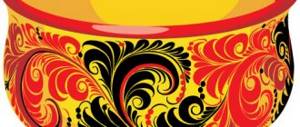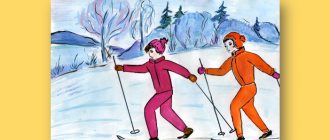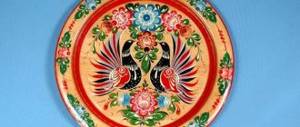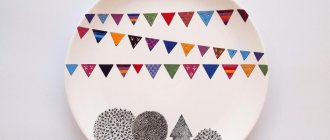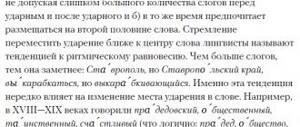Where to start? With preparation!
Gzhel is a whole direction of Russian culture. Gzhel painting is done on a white background with blue, light blue, azure colors, and paints of other shades. It is unlikely that anyone has not seen objects painted using this wonderful technique. Even if someone has not seen it, you can get an idea by looking at this wonderful dish. Can you imagine how it will decorate the table, turning it from ordinary to festive?
Please note: all drawings using the Gzhel technique consist of brush strokes. A special Gzhel (double) stroke is applied from the wide part to the narrow part. First, use the flat side of the brush, then turn the brush slightly and paint with the narrow part. This can be clearly seen in the video, where masters show how they paint an object. There are many such recordings on YouTube.
To teach children, you first have to master the technique yourself. An art album on Gzhel according to the Federal State Educational Standard will be very helpful with this. The value of the publication is that it describes the drawing process step by step and shows it in pictures. He also tells how to teach children the features of strokes and the sequence of painting. There are also practical tasks for studying the elements of painting in the album “Rossinochka” based on Gzhel. The manuals have different authors, but both are good from a practical point of view.
Gzhel painting: master class
To start work, let's prepare the surface for work - clean the mug with acetone and cotton wool.
Then we sketch a sketch on a piece of paper.
Squeeze brush No. 4 No. 2 slightly with pliers. Apply blue or blue paint to the top and white paint to the bottom; use a brush to make a back-and-forth motion on the leaf to create a gradient.
On the mug we select the place where the petals will be drawn. Or, as in the picture, make a circle with your finger.
At the bottom of the circle we draw petals; if you are not sure of yourself, draw on paper first.
Wait for the petals to dry (acrylic dries quickly, but it's best to wait about thirty seconds), then draw the next ones and finish the rose.
When the rose is dry, add stamens to the middle of the rose using a #1 brush. Using the same brush we draw a stem, you can also decorate it with leaves.
We finish drawing the berries, or fill the empty space with leaves. This concludes our work. The last action to complete the composition is the tea in this cup.
In addition to dishes, ceramic figurines are painted. For example, this figurine —
the horse is painted in Gzhel style. You can give this figurine to your family and friends.
All these animals are also painted with Gzhel. Well, isn't this wonderful?
But this kind of work 50 years ago would have seemed outlandish. Although at this time, I think the word wildness is disappearing.
There is also such a wonderful job with the service.
Initially, only dishes and figurines were painted with Gzhel, but nowadays almost everything is painted with Gzhel: even cabinets in the kitchen and glass jars into which housewives pour spices. If only there was desire and imagination. In addition, such works would be an original gift for friends or relatives. Have fun creating.
What will you need for work?
- Paints are white and blue, shades of blue. For the first time, white and blue are enough. For painting you can use gouache, watercolor, acrylic.
- Brushes. Paint with flat synthetic brushes of different numbers. You can try No. 7, which gives a fairly large smear. Thin brushes are suitable for painting blades of grass and other elements.
- Stencils on which children will practice and perfect their strokes before painting dishes. They can be found on the Internet and printed, or taken from special publications. Wooden stencils work well - for example, this teapot. On the one hand, you can paint it according to the applied design, on the other, you can paint it yourself.
- Ceramic, clay, wooden or plastic tableware (plates, cups, saucers).
- Jars for water, simple oilcloth, paint removal wipes, clothing protection, etc.
Gzhel painting presentation on drawing on the topic
Slide 1
Gzhel painting Completed by: Dyachkova Svetlana Aleksandrovna, 541 gr., PMDO Chelyabinsk 2010
Slide 2
Plan History of the craft Technology of ceramics production Dictionary Distinctive features of Gzhel painting Crossword Lesson summary for children in the preparatory group
Slide 3
1. History of the fishery. The oldest mention of Gzhel was found in the will of Ivan Kalita dated 1328. Gzhel was later mentioned in the spiritual letters of other princes and in the will of Ivan the Terrible in 1572-1578. It all started with clay. Nature itself has endowed this area: here is the Gzhel-Kudinovskoe deposit of fatty refractory clays. It is underground, and on its surface there are small hamlets and villages. But how much do our handy people need - there is clay, there are hands - that’s great! Widespread mining of different types of clay was carried out in Gzhel from the middle of the 17th century. In 1663, Tsar Alexei Mikhailovich issued a decree “to send clay to the Gzhel volost for apothecary and alchemical vessels, which clay is suitable for apothecary vessels.” In 1770, the Gzhel volost was entirely assigned to the Apothecary Order “for alchemical utensils.”
Slide 4
In the 18th century, Mikhailo Lomonosov, who was looking for the secret of porcelain and who appreciated Gzhel clays, wrote such sublime words about them: “There is hardly any earth in the world that is the purest and without any admixture, which chemists call virginity, except among the clays used for porcelain, This is our Gzhel, which I have never seen anywhere with a more beautiful whiteness.” Until the middle of the 18th century, Gzhel made pottery that was common for that time, made bricks, pottery pipes, tiles, as well as primitive children's toys, supplying Moscow with them.
Slide 5
By 1812, there were 25 factories producing tableware in Gzhel. In addition to dishes, toys in the form of birds and animals and decorative figurines on themes from Russian life were made in Gzhel. Shiny white horses, riders, birds, dolls, and miniature dishes were painted with purple, yellow, blue and brown paints in a unique folk, Gzhel style. The paints were applied with a brush. The motives for this painting were decorative flowers, leaves, and herbs.
Slide 6
After 1802, when light gray clay was found near the village of Minino, the production of semi-faience arose in Gzhel, from which kvass, kumgans and jugs were made in large numbers. Since the second half of the 20s of the 19th century, many products were painted only with blue paint. Semi-faience was distinguished by its rough structure and low strength. Around 1800, in the village of Volodino, Bronnitsy district, peasants, the Kulikov brothers, found a composition of white earthenware. The first porcelain factory was founded there around 1800-1804. Pavel Kulikov, its founder, learned the technique of making porcelain. Wanting to keep the secret of porcelain production, Kulikov did everything himself, having only one worker, but, according to legend, G. N. Khrapunov and E. G. Gusyatnikov secretly entered Kulikov’s workshop, copied the forge (oven for firing products) and took possession of clay samples , after which they opened their own factories. The Kulikov factory is remarkable in that it originated the Gzhel porcelain production.
Slide 7
The second quarter of the 19th century was the period of the highest artistic achievements of Gzhel ceramic art in all its branches. In an effort to produce fine earthenware and porcelain, production owners constantly improved the composition of the white mass. Since the middle of the 19th century, many Gzhel factories have fallen into disrepair, and ceramic production is concentrated in the hands of the Kuznetsovs, who once came from Gzhel. After the revolution, the Kuznetsov factories were nationalized.
Slide 8
Only in the middle of the 20th century did the restoration of the fishery begin in Gzhel, which recently celebrated its 650th anniversary. In the 1930s and 1940s, almost half of all porcelain and earthenware enterprises in Russia were concentrated here. In 1912, a station was opened on the Kazan Railway on the Moscow-Cherusti branch, which was named after the area “Gzhel”. The urban-type settlement that grew up near the station is also called “Gzhel”.
Slide 9
All pottery craft in Russia has deep historical traditions. Many crafts remain famous today. One of the first places is occupied by Gzhel - the largest ceramic industry in terms of production scale. Gzhel is an ancient village on the banks of the Gzhelka River, located in the Ramensky district of the Moscow region, 60 km from Moscow. The richest clay deposits are located here today. The village got its name from the word “zhgel”, i.e. “burn” or “burn” - all these are words from the vocabulary of ancient potters.
Slide 10
2.Ceramic production technology. Now the technological chain is built like this: Molding (casting in plaster molds) – Drying – Manual inspection – Control for cracks – Firing (electric furnace) – Painting workshop. Behind these “production” words lies the secret of the creation of Gzhel products and the work of many people: incl. technology masters, sculptors, foundry workers, ceramic artists! Gzhel clay has special qualities: high plasticity and refractoriness. She's fat, that is. there is little sand in it. The accumulated clay undergoes thorough primary processing: freezing, elutriation, kneading. Clay is a living material!
Slide 11
3. Dictionary: Porcelain is a product of fine ceramics, impermeable to water, usually white, ringing, translucent in a thin layer. Porcelain raw materials: kaolin, plastic clay, quartz and feldspar. And the proportion of components is a secret! Porcelain is usually produced by high-temperature firing. Faience is a product of fine ceramics, dense and finely porous. It differs from porcelain in its greater porosity and water absorption, which is why all earthenware products are covered with a thin continuous layer of glaze. Earthenware raw materials: 60-65% plastic materials (kaolin, clay); 30-36% quartz; 3-5% feldspar. Faience is produced by three-stage firing: biscuit (t-1250˚), glaze (t-1100˚) and pattern-fixing (t-700-900˚). Ceramics are products made from baked clay. Majolica is artistic ceramics, i.e. covered with opaque glaze. Kvasnik is a jug with a hole in the center. Kumgan is a vessel in which in ancient times drinks were served on the festive table. Kumgans are jugs that look like a bird with a rounded body, a flat, curved nose and a tail handle.
Slide 12
4 . Distinctive features of Gzhel painting. Any Gzhel painting is pleasant to look at; Gzhel motifs can be seen not only on porcelain, but also on paintings, embroidered and painted, and on clothes, on bed linen, and even in the interior, for example, painted fireplaces.
Slide 13
How is it different from other paintings? The signature color of Gzhel painting is juicy blue, bright blue, cornflower blue, the color of sky and water. Just one paint – blue on a white background, and the picture comes to life, and blue tints appear from dark to blue, depending on the pressure of the artist’s brush. The artist has only one paint, cobald, which turns it blue. It is diluted with water and the work is covered with strokes and lines.
Slide 14
The most favorite pattern is the Gzhel rose. Sometimes it is depicted large, with broad strokes. And sometimes it is written with a thin brush. Then we see a bouquet of several roses. The flowers are scattered all over the surface. It also happens: there is no rose itself, there are only its petals. They also decorate porcelain with strange birds and scenes from people’s lives.
Slide 15
Many works of Gzhel are unique and the plot depends on the master and his skill, and of course they are done by hand, so you won’t find exactly the same one. But of course there are characteristic elements, and these are the ones that are taught in every school in art class.
Slide 16
Gzhel painting is divided into three types: 1. The main one is plant painting - grass, cereals, berries, twigs, leaves, bouquets and garlands of flowers. In addition to roses, poppies, dahlias, lilies, peonies, asters, carnations, and daisies are depicted. Their form is a little conventional. 2. Ornamental. First of all, these are checkerboards - several rows of blue and white squares along the side and a tie-down belt also along the side. Artists also painted the famous Gzhel grids - “combs” (in the form of a spruce), “droplets”, “pearls”, “antennae”. Using a brush with hard bristles, a marbled pattern is applied. It fills the space inside, for example, wavy lines, or circles at the bottom of a plate.
Slide 17
3. Plots. This is nature and the seasons. These are scenes of city life, rural landscapes and everyday life, etc. These are characters from Russian fairy tales: Blue Birds, Polkans, Sirin's birds, various Mermaids, Bayun Cats, etc.
Slide 18
The main secret is the strokes. A smear is a generic sign of Gzhel. The main technique is the correct ratio of blue and white or the combination of “the whiteness of the snow-covered fields of the Moscow region and the transparent blue of the clear sky.”
Slide 19
Another rule is that each subsequent stroke is different from the previous one. First, paint is applied thickly to the brush. Next, with different pressure, lay out the flower with a brush. The first strokes are the most juicy, but as they decrease they become lighter. The round petals of the flower are either clear or softly “blurry”. This is how multi-petaled flowers are drawn. After firing, the flower becomes cornflower blue.
Slide 20
"Brushstroke with shadows." The paint is drawn onto one side of the brush and applied with a light circular turn, i.e. turns around the handle. In the thicker part of the brush there is more paint - the stroke is dark, towards the middle of the paint there is a little less - the stroke is lightened, and the thin tip leaves a very light trace. This creates a multi-colored three-dimensional rose or leaf.
Slide 21
And painting with “one brush” is achieved when a cornflower or a twig is painted with one set of paint on a brush - then the first petals will be dark, and the rest will gradually become lighter.
Slide 22
The “ABC of Strokes” is supplemented with other elements. The thin tip of the brush is used to paint the stem, tendril-curls, veins on the leaves or shading. Sometimes the blue color is painted with thin golden lines and strokes, which seem to indicate contours. But this is a matter of taste. You can't edit!
Slide 23
To paint a rose, you need a medium-wide brush. We turn it around the cutting, then from the middle of the flower we apply wide strokes of blue and light blue paint, i.e. as if we were building up the petals with broad strokes. To comprehend the “ABC of Strokes,” artists need about ~5 liters.
Slide 24
The sequence of painting a fairytale bird.
How to draw using the Gzhel technique in the senior group?
Each professional master class of a Gzhel specialist involves at least several classes. We will also focus on this and learn step by step. I can suggest something like this:
- A story about Gzhel - a painting technique, a type of craft and art. Display visual materials to interest children. These can be pictures or objects, preferably funny and eye-catching. For example, like these piglets (by the way, they can really be used on the farm). Stroke practice on paper.
- Stencil painting (coloring), elaboration of the ornament, fixing the stroke. We learn to confidently draw a drop, a blade of grass, a curl, a spiral, a wavy line. The stencil can be on a regular sheet or cut out in the shape of a jug, teapot, or cup. It is better to use gouache.
- Painting of tableware. The ideal option is to draw a traditional Gzhel rose with variations. Children will both learn and learn the name. Acrylic paints will perform better. It is difficult to draw on a convex or concave workpiece, especially for the first time; you will need the help of an adult.
Variations are possible in any of the points. You can make the blank with your own hands - for example, mold flat medallions-“plates” with a diameter of about 8-10 cm from clay, dry it, paint it with white paint, apply a pattern with a pencil (blue felt-tip pen) and paint it. Here's a souvenir for March 8 or grandma's birthday! You can draw on plastic or other disposable utensils; such “blanks” are inexpensive and do not require labor to prepare.
Under Gzhel, you can paint templates in the form of eggs for Easter, postcards. Or you can buy white cups for painting, give them to children to paint, and then cover them with a special varnish and give them to families. Can you imagine what a memory this will be for years to come?
Gzhel painting step by step
The main motives of this type of painting are plant and animal ornaments (birds, flowers, animals). Let's try to do something in the style of Gzhel painting - how to draw an ornament on a plate.
Tools and materials:
- White clay plate, not covered with glaze,
Paints
Brush
Simple pencil
So, first we draw a diagram of the future drawing with a simple pencil. The design will consist of a simple ornament and a large flower in the center of the plate.
The border, or border, is drawn without first applying it with a pencil. This can be a wavy line with dots placed in every second indentation (“wave”).
To draw a flower, make a mark in the center of the plate.
Rose petals are drawn with shadowed strokes. It is from the bud that we begin our painting. Then we move on to drawing the petals. As a result, we should get an image like this:
The border can be made like this or simpler, in one of these styles:
So, Gzhel painting (pictures of which you have already studied with us) is not difficult and very beautiful. And it is also accessible even to children, especially if patient parents come to their aid. Draw together, and you will succeed, even painting dishes or small souvenirs using this technique.
From time immemorial, Gzhel has been one of the most beautiful paintings. The name appeared due to a vast area called the “Gzhel Bush”, located about one and a half kilometers from Moscow. Basically, Gzhel includes cool colors, usually black, blue, light blue. It is customary to paint dishes, sets, and ceramic figurines with Gzhel; recently there has been a tendency to paint nails with Gzhel. If you are new to this field, I will show you how to draw under Gzhel with instructions in pictures.
Now you know a few elements. I will show you how to draw a Gzhel painting step by step.
How to draw sketches using the Gzhel technique?
Gzhel (painting for children can be created not only on paper, but also on plastic or wooden polished surfaces) allows the artist to decorate various household items not only with standard ornaments, but also with multi-component compositions with a traceable storyline.
Flowers
There are several ways to paint flowers using Gzhel painting (usually used in tableware decoration):
| Final image option | Algorithm for its creation |
| 1. Using the shadow stroke technique, draw a small heart in the upper part of the working plane so that its upper borders are wider than the lower ones. 2. From the corner of the heart, mirror 2 semicircles to the right and left, exactly repeating the bending force of each other. The extreme points of the semicircles must be connected at the bottom and top. 3. In the area where the heart joins the semicircles, draw a small circle inside the figure. 4. Fill the space between the semicircles with slightly curved lines, connecting them together. 5. To the right and left of the outline of the main shapes in the area where the heart and semicircles connect, draw one more semicircle. 6. Make the bud more magnificent by drawing additional petals around the outline of the lower figure from the outside. | |
| 1. In the center of the sheet of paper you are using, draw 2 semicircles (one with a downward bend, the other with an upward bend) so that their extreme points are located close to each other. 2. By drawing additional lines from the bottom of the lower semicircle, add volume to the contour of the flower bud. 3. Under the bud, draw 2 smoothly curved lines, the extreme points of which should be drawn above the middle of the side edges of the bud. 4. From the exit point of the lines shown in step 3, draw 2 more semicircles, pointing them down. 5. Using 2 straight lines, fill in the distance between the lines created in step 4. 6. At the top of the bud, draw a spiral imitating closed petals. |
Plants
It will also be interesting for children to create paintings with Gzhel depicting plants, most often used in the decoration of kitchen utensils or wardrobe items.
| Final image option | Algorithm for its creation |
| 1. From the top center of the working plane, draw a smoothly curved line, directing it to the lower left corner. 2. Draw smoothly curved strokes along the entire length of the line on the left side, placing them at a distance of 1-2 cm from each other. 3. Along the entire length of the line on the right side, draw 2 smoothly curved strokes (from below), and fill the rest of the space with dots, the intensity of which should be in descending order (large and dense at the bottom edge of the sheet, small, barely noticeable at the top). | |
| 1. In the center of the working plane, draw 2 lines curved into a spiral, drawn from one point located at the bottom border of the sheet of paper. 2. Draw 2-3 more curves from the sides of the spirals, repeating the bends of the main lines. 3. At the line in the lower part of the working plane, on the left, draw rich, wide strokes. 4. Fill the space where the spirals diverge in opposite directions by drawing 3 lines of different sizes in these areas, coming out from one point. 5. From the starting point of the main lines, draw a curve, at the end of which draw a leaf using a wavy line 6. On the side of one of the spirals located on the right side of the sheet of paper, draw 4 dots at a distance of no more than 1 cm from each other (provided that the image is created on a sheet of A4 format or smaller). |
Animals
Images of animals created in the style of Gzhel painting are most often used to decorate interior items or clothing.
| Final image option | Algorithm for its creation |
| 1. Draw an even circle in the center of the working plane. 2. Inside the circle, using the above algorithms, draw the outlines of plants and flowers, leaving the middle part of the figure white. 3. Draw a curved line up from the bottom edge of the circle, directing it to the upper left corner. 4. Continue the line in a semicircle, curved upward, directing it to the upper right corner. 5. Sharpen the connection, then continue the contour by drawing, without lifting the brush from the sheet of paper, the fox’s face and its ears using a semicircle and 2 triangles. 6. Draw a smoothly curved line down to the base of the circle. 7. Detail the image by more clearly drawing the animal’s paws, as well as its eyes, nose and mouth. 8. Along the lower border of the main figure, draw an oval (fox tail) so that the left part of the tail is approximately twice as wide as the left. |
Birds
Gzhel painting with images of birds is most often used to decorate dishes, kitchen utensils (for example, cutting boards) or wardrobe items.
| Final image option | Algorithm for its creation |
| 1. In the center of the working plane, draw a slightly curved wide line, positioning it vertically (the body of the bird). 2. To the right and left of the main figure, closer to its upper edge, draw curves, one of which should be directed up and the other down (bird wings). 3. Draw semicircles from the middle of the side curves, the extreme points of which should be located on the main line. 4. Make the upper part of the main vertical wider by drawing a small semicircle (bird’s head) close together. 5. Along the entire length of the side curves, around semicircles, draw diagonals, the outer edge of which should be thicker than the edge located close to the body of the Gzhel bird (bird plumage). 6. At the bottom of the body, draw ovals, pointed at the edges (the legs of the bird). 7. From the area between the right wing and the bird’s leg, draw smoothly curved lines, directed randomly, placing them close to each other (the bird’s tail). 8. Detail the image of the bird by drawing eyes, beak and crest on its head. 9. Using various techniques, fill in the inside of the drawn object, thus indicating the plumage and color of the bird. |
Story pictures
It is recommended to start creating plot pictures in the style of Gzhel ornament only after the application of basic fine art skills by the young artist has been brought to perfection.
| Final image option | Algorithm for its creation |
| 1. Retreat 1-2 cm from the lower border of the working plane. 2. At the indicated distance, draw several chaotically curved lines connected to each other and forming a semicircle with a downward bend (waves). 3. Along the entire length of the depicted waves, on both sides, draw many small dots that give volume to the image. 4. Above the curves, retreating 3-4 cm, draw a semicircle curved downwards (the bottom of the ship). 5. Connect the top points of the semicircle with a wavy line (the top of the ship). 6. Draw 3 small circles close to the top border of the ship. 7. Above the circles, using lines smoothly curved in opposite directions, draw sails. 8. To the right and left of the drawn ship, draw a fish using simple geometric shapes and straight lines. 9. Fill the space above the ship with closely spaced semicircles, grouped in twos (birds). |
History of Gzhel and its origins
The name of this folk craft is associated with the village of Gzhel, located in the Moscow region. This place is very picturesque, but not fertile. For a long time, the residents of this village tried to engage in agriculture. However, their time was wasted. All the failures were associated with a huge layer of white clay that lay almost on the surface. After it became known about the high quality of this clay and the fact that it makes excellent porcelain, a folk craft associated with the production of various pottery products was born. Local craftsmen created not only dishes, but also children's toys. The first pottery products of this area have been known since 1320.
Gradually, the original drawing, unique painting and amazing originality of Gzhel became very popular, and individual workshops merged into large productions.
There is an opinion that at first this folk craft was called “zhgel”, and then for ease of pronunciation they switched to the word “Gzhel”. The very name of the village meant “burn.”
What do you need to create patterns on paper?
When working with children, in the vast majority of cases, traditional tools for creating Gzhel painting (cobalt oxide, spatulas, reagents, etc.) are not used for safety reasons. Young artists learn to draw patterns in this style on paper.
For a comfortable working process, the child must be equipped with:
- thick sheets of paper or white cardboard. Thin pages are deformed under the influence of water and paint, causing the appearance of the entire work to become significantly worse;
- blue and white paints. It is not recommended to give your child more flowers in order to better form his understanding of Gzhel painting. Gouache, oil paints or rich watercolors are suitable for work;
- brushes (it is recommended to provide the child with 2-3 types of brushes, varying in thickness);
- palette (the young artist will need it when mixing colors to obtain the required shade of blue);
- container with water;
- a piece of fabric made from natural materials (you can not only wipe your hands with it if the need arises, but also correct the image recently applied to the working plane);
- stencils (especially important if a young child who does not have fine art skills is learning to paint).
Color scheme of Gzhel painting
Gzhel painting was initially done exclusively with blue paint (shades are allowed). It is this feature of this art form that makes it difficult for beginners to perform even in this day and age. Not every artist can create a beautiful drawing using a limited number of colors.
The main colors used by masters in Gzhel painting are:
- snow-white color (always used as a background shade, since it does not set off the contrasting paint with which the main ornament is created);
- all shades of blue , the most popular of which are deep blue and pale blue;
- cobalt color (dark shade);
- white paint color (used for mirror painting, when the ornament is created on a blue background - on the contrary, in comparison with classical Gzhel painting);
- gold (a modern innovation by artists who, using a noble shade of gold, strive to place accents on a hand-created image);
- platinum (rarely used, also to focus the viewer’s attention on specific details of the ornament).
patterns for beginners. Painting dishes with Gzhel patterns
Gzhel, a small town in the Moscow region, is the center of Russia's famous artistic craft. The so-called Gzhel bush occupies a vast territory and includes 27 villages, the population of which has long been engaged in painting a variety of products from snow-white porcelain and earthenware. The history of Gzhel fishing can be traced back to the 14th century, from the very time when a rich clay deposit was discovered near Moscow. The material was heterogeneous: in the upper layers there were layers of simple red “shirevka”, below there were layers of pale yellow “fur”, and in the very depths there was “soap” - the most delicate white clay, an excellent material for making high-quality porcelain and earthenware products.
Pharmacy needs
For some time, dishes and other kitchen utensils were made from white clay. Then the Tsar's Pharmacy Decree appeared, ordering the sending of all extracted raw materials to Moscow for the needs of medicine and pharmaceuticals. The production of kitchen utensils had to be postponed, but after some time additional deposits of white clay were discovered, and thus there was already enough material for both pharmacies and pottery production. During the time of abundance of raw materials, an artistic craft called Gzhel was born.
World fame
Gzhel painting, whose patterns are distinguished by a special style, began to spread throughout Russia. At first, artists used multi-colored paints. Then Gzhel painting, patterns, themes of the drawing and the general style changed somewhat. The main color was bright cobalt blue paint. Since then, Gzhel painting, whose patterns are admired by people all over the world, has become a classic combination of two colors - white and blue. Genuine products do not allow any other shades; only in some cases the artist can use gold paint for light decoration.
Heyday
The famous Gzhel painting (patterns, ornaments, plant themes and much more that forms the basis of the unique artistic style) developed in the 19th century. In wealthy Russian homes, it was considered good manners to serve the dinner table with dishes made from Gzhel porcelain. First of all, behind this was patriotism, pride in one’s country. In addition, white and blue plates and tureens were an order of magnitude cheaper than Meissen porcelain.
The images on the products were also exclusively Russian themed. Hunting with dogs, dancing on Maslenitsa, the procession of the cross on Easter and many other events of a truly Russian nature were depicted on tableware. Thus, Gzhel painting, the patterns of which were close in spirit to the Russians, became increasingly popular.
Handmade
At the beginning of the 20th century, factory owners in the Moscow region made attempts to put the production of white and blue products on stream, but this idea failed. Painting dishes with Gzhel patterns must certainly be done by hand by experienced artists who are able to put their soul into their work. Mechanical drawing destroys the essence of art, the product becomes faceless.
Gzhel painting, patterns and ornaments, geometric figures or scenes from village life - all this is the result of the creativity of talented artists working at the Gzhel Bush folk art enterprises. The first sign of the artist’s skill is the presence of halftones in the painting, when pale blue strokes alternate with bright and saturated ones.
Gzhel painting: patterns
A flower, its delicate petals, a plant stem, leaves on thin cuttings... All this is a classic theme of Gzhel painting. The plants are depicted in a stylized form, but their characteristic features are visible; currant berries cannot be confused with viburnum, and gooseberries cannot be called rose hips, even though all the plants, flowers and berries are the same bright blue color.
Children's theme
A significant part of Gzhel folk crafts is dedicated to children. These are horses and elephants, donkeys and foals, painted trailers with a train, cars and planes with Gzhel painting. Patterns for children are just as skillful as for adults, but the artist approaches his work with much greater responsibility. After all, a child should under no circumstances be disappointed. Therefore, artists, when starting to paint toys and other children's products, try to do the job as best as possible.
Master classes
In the production associations of Gzhel folk art crafts there are sections for training those wishing to master the art of painting. Future artists take special courses in drawing and technologies for creating the famous blue and white porcelain products, and master a type of folk craft such as Gzhel painting. The patterns for beginners are simplified, however, the learning process consists of several stages.
The first lessons include learning to draw, or rather, to draw the contours of a future image. The strokes are applied with a medium-soft drawing pencil onto Whatman paper without pressure, so that poorly marked lines can be erased with an eraser.
After the outline drawing is ready, you can start coloring. It is better to make a test image with water-soluble paint - watercolor, acrylic or gouache. Any brush will do for this, but to start, you can use number 2. On a separate piece of paper, you should make several strokes to select a blue color that is suitable in saturation. Then you need to try to draw a flower. If the image on paper turned out well, then at the next stage you can begin painting the ceramic product.
Variety of patterns
The database of each Gzhel ceramics enterprise contains plot and thematic sketches that are used, if necessary, by technologists. A variety of Gzhel paintings, patterns, photographs, drawings, copies - everything comes into play when you need to launch the next series of products.
Author's products are produced in separate batches, when the products are maintained in exclusivity status from start to finish. Their shape is unique, their painting is inimitable. This type of Gzhel is highly valued; connoisseurs try to purchase this particular product. First-class products differ from ordinary ones in the detailed elaboration of the design. The artist draws the smallest nuances, and as a result, a true masterpiece of Gzhel folk craft is born.
Sales on site
Recently, a good tradition has emerged - in Gzhel production, opening a store selling products from local craftsmen. Works of art have become more accessible and the choice has increased. Large enterprises of the Gzhel industry have launched the production of super services, similar to those supplied to the imperial court in the 19th century. Representatives of previous generations remember dinnerware sets containing 120 or more pieces. There were also smaller sets, for 12 people out of 84 items. And very small ones, for two, called “Tete-a-tete”. There was even a miniature set for one person called “Egoist”.
Tsarist monopoly
In those distant times, a lot of Gzhel products went abroad. Europeans exported products of Russian craftsmen by wagonload. This went on for quite some time until the Russian Imperial Treasury Department became the main buyer of factory products. Quite quickly, a monopoly arose, which subjugated the production of Gzhel, and since then all products have been shipped to the treasury warehouse.
Prospects
Currently, Gzhel is in demand more than ever. Factories and small workshops are operating at full capacity. All residents of the so-called Gzhel bush are engaged in the production of snow-white painted ceramics.
fb.ru
